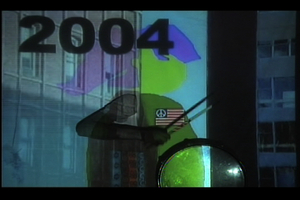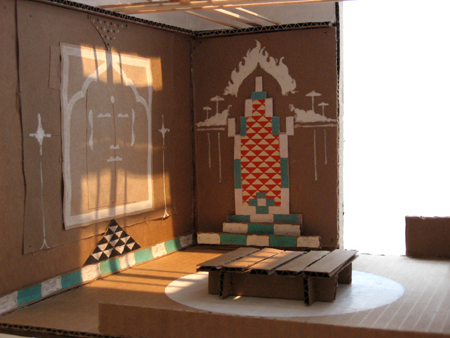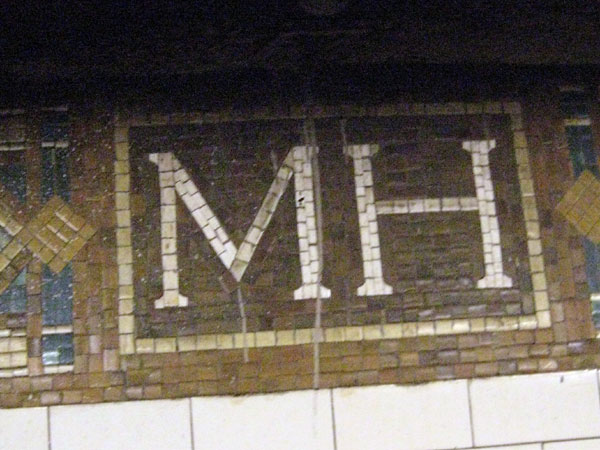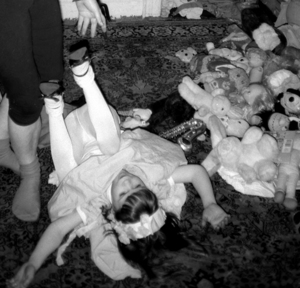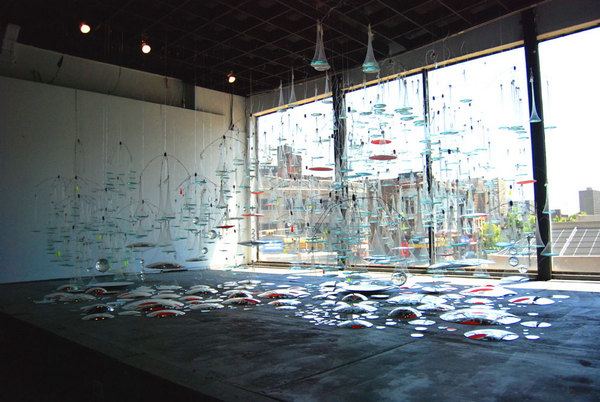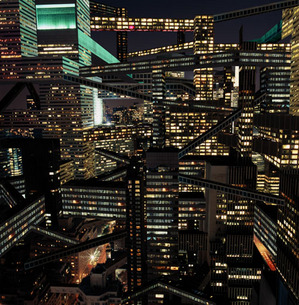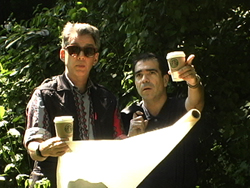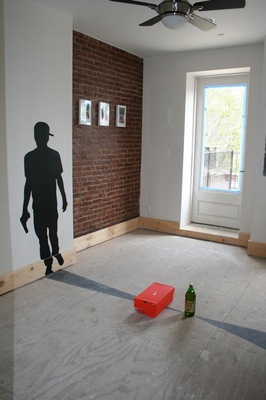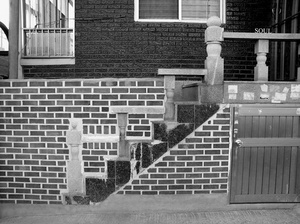This is an archive of the ArtCat Zine, 2007-2009. Please visit our new project, IDIOM.
June 2008
Half of the People Are Stoned and the Other Half Are Waiting for the Next Election
Tuesday, July 1, 2008 at 8pm
Presented by Light Industry at Industry City 55 33rd Street 3rd Floor, Brooklyn
"I love Mumbleboy!" That's not the kind of exclamation you would have heard from me before I met Hanna Fushihara Aron and her husband, the artist David Aron. Hanna's gallery, Little Cakes, cherishes the power held by all things gentle. In other words, everything I mistrust when it comes to art. And Mumbleboy? He's half of the duo known as Mumbreeze whose 2007 show at Little Cakes featured paper maché super heroes. This is not something I would have found immediately convincing had Hanna's curatorial tastes not already demonstrated the weight in whimsy so many times before.
The Public Art Fund throws the switch on Olafur Eliasson's New York Waterfalls tonight. The work consists of four gigantic man-made waterfalls installed along the shores of Brooklyn, Manhattan and Governor's Island. Nothing irks the crotchety corpse of the Protestant ethic quite like a massive public expenditure on art; for months people have been complaining about the cost of the project, and granted, its not cheap. But what's missing in these appraisals, in addition to an understanding of the economic impact of such spectacles, seems to be an appreciation for the idea itself. Eliasson has said that part of his aim was to rekindle New Yorkers' awareness of the giant bodies of water that surround them, which seemed a stretch to me at first until I remembered reading sportswriter Peter King's account of The Gates a few years back, "Saw The Gates... Nice. Unusual. Great to see Central Park so packed with people and transformed into a pretty sight in the middle of a harsh winter. An enjoyable experience. But art? I don't see it."
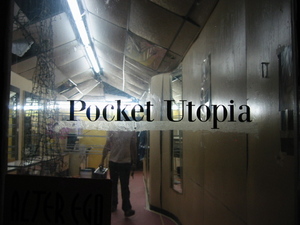
This Friday is the first of two animation nights at the Phatory, the other being July 18. Featuring work by Asteriskpix, Brian Dewan, Mike Estabrook, Elise Engler, Brent Green, John Goras and Jim Torok. Jill Connor curates, 7-9pm.
Saturday at 9pm is the New York premiere of Andrew Hahn's 52-minute no-budget bio-pic of the Unabomber entitled 'Manifesto.' David Hughes stars as Ted K. At Rental Gallery, located at 120 E. Broadway, Floor 6, NY 10002
And lastly, the final 'Social Sunday' from 4-6pm at Pocket Utopia. Celebrating the last day of the current show featuring photography by Luke Abiol, Eric Hairabedian, and Kristopher Graves, refreshments available.
2nd Annual Mott Haven Open Artist Studio Tour
12-6pm, Saturday, June 28th
Mott Haven, The Bronx
This Saturday commences the 2nd annual Mott Haven Studio Tour. Start time is twelve noon at the 138 St stop on the four/five or the 138 St/3rd Ave stop on the six. Free trolleys run every half hour till five, after party at Haven Arts, 50 Bruckner Blvd. from 6pm-8pm. Printed maps available day of at the Mott Haven NYPL at 321 E 140th St; at Haven Arts; on the Bronx Culture Trolley; and at all locations on the tour. In addition Stacey Gershon, curator and independent art adviser, will lead a tour to select studios. To RSVP, please contact Laura Napier at 718-401-7866 or email.
All In The Family - Screening
8:30 sharp - June 25, 2008
Sara Meltzer Gallery, 525-531 West 26th
“There is no subject without, somewhere, aphanisis of the subject, and it is in this alienation, in this fundamental division, that the dialectic of the subject is established,” Lacan remarked in his seminar of June 3, 1964 - one of the texts cited in Peggy Ahwesh’s film Martina’s Playhouse, which is included in a group screening this Wednesday at Sara Meltzer. Aphanisis, for its part, is the old psychoanalytic term for the loss of sexual desire. Historically considered to be merely the basis for all neuroses, Lacan still managed a conceptual upgrade by arguing that all subjectivity is structurally neurotic, and thus that aphanisis is, in fact, the central process by which the signifier, inevitably on loan from the symbolic, comes to undo the classically Cartesian subject. By filming herself helping the child Martina, (she of the playhouse) to read this text out loud, Ahwesh provides one of the more delightfully knowing pedagogical diagrams in recent memory. Moreover, it is to Ahwesh’s great credit that not only does one not need know Lacan (or Bataille for that matter) to appreciate this film, but that; indeed, it frequently does a better job of illustrating his ideas than he does.
A screening organized by Laura Parnes, artists include Peggy Ahwesh, Patty Chang, Eteam, Rico Gatson, Liselot van der Heijden, Lovett/Codagnone, Kristin Lucas, Guy Ben Ner, Laura Parnes, Shannon Plumb, Barbara Pollack, and Martynka Wawrzyniak.
Surfactant - A Group Survey
Rupert Ravens Contemporary
85 Market Street, Second Floor, Newark, NJ
In Surfactant, as 17 artists chart immanent relationships amidst a stratum of novel material, surface tension waxes and wanes (a surfactant is a substance that reduces the surface tension of a liquid in which it is dissolved). In the midst of mining obfuscated properties embedded in the art terrain, the viewer is propelled into an intensive dialogue with the historical and metaphorical qualities of each of these works. Capped eloquently by Charles Baudelaire’s “On the Heroism of Modern Life” from Salon of 1846, “Absolute and eternal beauty does not exist, or rather it is only an abstraction creamed from the general surface,” therein divulging inner layers of the objects and installations presented.
With her triad of Asian-styled cylindrical structures, Gae Savannah takes on superficial fashion and “life of Girl.” These towering columns, housed in over-the-top fabric, embody the element of surprise. Topped with pagoda-like peaks, Savannah’s gangling tourelles contain tiny enclosures mimicking mini-boudoirs whose seduction is ultimately subverted by their reduced scale and inaccessibility. In Lu Shia, a plastic shower curtain wraps around its conical understructure while abbreviated details, such as a piece of lavish, quasi-fluorescent fabric, drape and tuck around an interior space like shining satin found in draperies in an Old Master painting, gone “Girl.” With combined references to the oriental and occidental, the ritualistic wrapping of fabric functions both inside and outside the structures, layering the work with cultural and metaphorical meaning. Not content to arouse the viewer with mere self-referentiality, these three regal beauties, in all their gleaming glitterati, strike a pose on a fictitious pop culture runway.
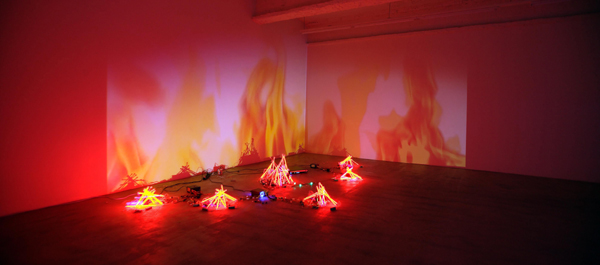
From Another Shore: Recent Icelandic Art
May 1 - August 15, 2008
Scandinavia House - 58 Park Avenue
Initially, the most noticeable works at the gallery at Scandinavia House are the pieces comprising Haul. Five tiny models scattered around the floor envision lightly populated landscapes; viewed from above, the sculptures give visitors the effect of the ground viewed from an airplane window. Referencing the artist’s own tendency to move around the world, the landscapes are built within cargo crates sized to fit them; the crates themselves look haphazardly opened and ready to be packed back up at any moment. Their creator, Katrín Sigurðardóttir, is from Iceland, as are all the artists featured in From Another Shore – studies have brought her to San Francisco and New Jersey, and in that way she exemplifies a part of the premise behind the organization of the show.
The Future As Disruption
June 18 - August 1, 2008
The Kitchen - 512 West 19th Street
Science Fiction is not the only genre to maintain extensive pretensions to criticality, but it’s certainly been the most successful at popularizing representations of a more-perfect universe. From numerous Bellamy clubs in the first half of the 20th century, to Reagan’s infamous Star Wars fiasco sci-fi and its snooty sibling ‘speculative fiction’ have long provided a communal lexicon of already-popular terms for washing down wacky ideas. Beyond provisioning paint-jobs for cruder vehicles in the ideological garage however, sci-fi has also been a sort of halfway house for once and future earth-bound utopias. L. Ron Hubbard, Ayn Rand, and George Orwell have each, via careful trading on the prerogatives of fiction, managed to provide enduring portraits of reality that, for some, are not nearly alternate enough. Tonight, in any case, The Kitchen opens The Future As Disruption; a group show aimed at investigating (and hopefully also deploying) sci-fi strategies for good old critical-artistic ends. Rashida Bumbray and Matthew Lyons curate the work of Julieta Aranda, Joan Banach, Sean Dack, Jonah Freeman, Olalekan B. Jeyifous, Simone Leigh, Ann Lislegaard, Adam Pendleton, Mungo Thomson and William Villalongo. Opening reception tonight 6-8pm.
Michael Smith and Joshua White - Artists' Talk and Screening
June 17, 2008 - 6:30 pm - Free
EAI - 535 West 22nd Street, 5th floor
Longtime collaborators Michael Smith and Joshua White will screen and discuss some of their work tonight at EAI. White in particular has taken an interesting path towards his current installation work with Smith. After studying theater at Carnegie Mellon, White began designing psychedelic light shows for such famous industrialists as Janis Joplin, Jimi Hendrix, and the Doors. Later, White would design the "Warhol Party," scene for Midnight Cowboy as well as directing television episodes of Seinfeld, Club MTV, and Inside the Actor's Studio. Many of these spectacles would no doubt appeal to Smith's alter ego, 'Mike Smith,' who has long inhabited the artist's work as a sort-of tabula rasa of late capital, a subject to be worked on and through by the larger cultural machinery. The pairing of these two in 1997 can then be seen, bizarrely enough, as emblematic of the recently shrinking distance between audience and producer; as Mike, the conceptually perfect denizen of the administered world, gets a personal sandbox designed by his very own captain of consciousness.
Sensual Insight: The Contributions of the painter Xenia Hausner to Austro-German Iconography
6-8pm, 16 June 2008
Austrian Cultural Forum - 11 East 52nd Street, second floor auditorium
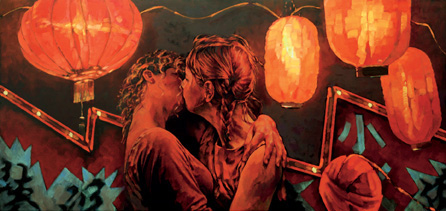
Tonight set-designer turned painter Xenia Hausner talks about her work with Bazon Brock. The daughter of Rudolph, Hausner's contemporary riffs on German Expressionism can currently be seen at the Forum Gallery. Brock is Professor of Aesthetics at University Wuppertal, Germany having studied Philosophy, Literature, History, Sociology, Political Science and Dramturgy. It's free, email for reservations.
Dear readers, I will be traveling internationally for several weeks this summer. It is my great pleasure, therefore, to announce that S.C.Squibb has agreed to act as managing editor of ArtCal Zine in my absence for much of this month and the next. S.C.Squibb has been contributing regularly to ArtCal since October of last year.
Anat Litwin is an artist, curator and founder of the HomeBase Project an exhibition program which manifests itself in a different, gentrifying New York City neighborhood each year. S.C.Squibb caught up with her downtown on May 22nd.
SS - So, you graduated from Hunter...
AL: Right. After I graduated I became the director of the Makor gallery at the 92nd street Y. It was just a week after I had finished my final project at Hunter and it was a really strong shift – going from being an art student to running a residency program, curating… I was creating a context for art. Though I wasn’t entirely focusing on my own work, I discovered the immense power of working in and for a context of an artistic group, and it thoroughly convinced me that kind of passion and interest in dialogue and study, is something very meaningful that's hard to find. There is such a thirst for that place. So In 2006 I started this project called Homebase independently from my job at Makor. 2006. I received a whole floor in a building from my landlord - it was an office for a Polish bank in Greenpoint, and I had it for two months before they were going to renovate it…
SS: So the space came first -
AL: Yeah, for the first project, and I was thinking – what am I going to do with all this space? How can I use it? I decided two things. First that I wanted to do an exhibition, and second, that I wanted other artists using the space, and working in a group - so I started Homebase I, with 12 artists, Israeli, American, Polish, local artists… and the topic of the exhibition was home – something so basic, its almost banal, almost gross – an exhibition about home? It's something that seems unsophisticated and invites a very sentimental dialogue, or rather it allows it to happen… so anyway, 12 artists, different mediums, different backgrounds; they all had a month and each got a room to create a site-specific work about home, and then the space was open to the public for a month.

Art in General Fundraiser
8pm - 11pm Saturday 14 June 2008
100 Lafayette New York, NY
$100
This Saturday Art in General hosts a special kind of fundraiser, billing the event as "part benefit, part performance art event, and part live concert." Put together by dealer James Fuentes and featuring a host of promising live performances, the benefit takes palce at 100 Lafayette -- the much discussed, officially unopened joint venture club whose perhaps most notable founders include artist Spencer Sweeney and party punk Andrew W.K. The latter of the two's fingerprints is definitely all over the multi-story club, which is adorned with with no-smoking type neon signs encouraging visitors to "EVERYBODY DANCE NOW," party hard, and like such affirmations of the Good Life. The emerging space, which has already been host to a few private and not-so-private events, features an interesting interior, spacious downstairs dance floor, and full bar which will be serving complimentary cocktails and beer for fundraiser patrons. Tickets are $100 and go to benefit AiG's fantastic exhibition, residency, and public programs.
In Discussion: Lawrence Weiner and Andrew Blake
7:30pm Wednesday 11 June 2008
Swiss Institute - 495 Broadway 3rd Floor New York, NY
Mapping Correspondence Panel Discussion
6:30pm Friday 13 June 2008
Center for Book Arts - 28 W 27th St, 3rd Fl. New York, NY
$10 suggested donation
This Friday the Center for Book Arts hosts "An Authentik and Historikal Panel on the Phenomenon of Mail Art" in conjunction with the exhibition Mapping Correspondence: Mail Art in the 21st Century. Mail art here is a loosely defined categorical framework for work which conceptually or formally rests on its circulation through postal systems. The form naturally becomes an emblem of a kind of errant 20th century vanguardism developed contrary to high art mandates of singular, precious art objects whose exhibition and circulation remains deeply managed to this day. Mail Art in the 21st Century has mobilized dozens of artists invited to participate in the show, and who in turn invited more collaborators, to produce new original mail art works reflecting "the complex and varied meaning of the book, mapping, and social networking in the 21st century." Panel speakers on Friday will be A.A. Bronson, who is an artist and director of Printed Matter, Martha Wilson, an artist and founder of the Franklin Furnace Archive, and artists John Evans, Barbara Moore, and William Wilson. The panel will be moderated by John Held Jr.
Tonight at the Swiss Institute meanwhile, assistant curator Piper Marshall will lead a discussion between artist Lawrence Weiner and well known adult film director and producer Andrew Blake. The occasion of the talk is Weiner's new work currently on view at SI through 19 July, Water in Milk Exists. For the exhibition, Weiner worked with the Swiss Institute and cinematographer Kiki Allgeier to produce a new video work which the press release promises to challenge "both artistic and pornographic conventions."
This year's three-day Bushwick Open Studios (BOS) – part of the larger Bushwick Open Studios & Arts Festival – landed on a blistering weekend in June that hindered studio hopping for everyone but the artistically most adventurous. The event demonstrated the growing presence of this north Brooklyn neighborhood in the city's artscape. A mixed bag of quality and vision, BOS has grown to include hundreds of artists in about 100 locations.
From the neighborhood's new downtown area near the Morgan L stop to the cemeteries near Jackie Robinson parkway, this huge swathe of New York's most populous borough attracted over a thousand art tourists from near and far.
Now with various non-profit institutions (Lumenhouse, 3rd Ward), four art galleries (Ad Hoc, English Kills, Pocket Utopia, Factory Fresh), a burgeoning downtown area (Morgantown) and an artistic energy that encourages experimentation, the latest installment of BOS may be proving that Bushwick is getting ready for a bigger role in the city's creative life.
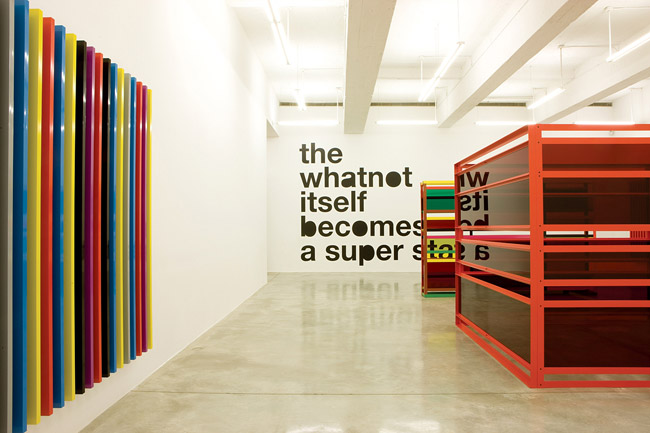
The State Itself Becomes A Super Whatnot
Liam Gillick
Casey Caplan - 525 West 21st Street New York, NY
8 May 8 - 14 June 2008
Recent economic and political crises, such as the sub-prime mortgage fiasco, have called attention to the problematic position of the nation state in contemporary global culture. The current American recession, whose genesis lies in the unprecedented growth of liquid capital in the global marketplace, and a complex series of obscure banking and investment strategies, has ended with United States government propping up investment capital, such as Bear-Sterns, in an effort to avoid a projected global meltdown. The oft-repeated explanation was that Bear-Sterns was "too big to fail." That is, its connections with the global marketplace ran so deep that a collapse of the company would set off a domino effect, wreaking worldwide financial havoc. The government must therefore protect this corporate citizen, or risk endangering its own position of power. The penetration of global capital into the apparatus of the state leads one to ask whether or not it is the tail that wags the dog. Liam Gillick raises some of these issues with The State Itself Becomes A Super Whatnot, his new solo show at Casey Kaplan Gallery. Gillick has made a career of repurposing minimalism and conceptualism into neatly designed objects embedded in complex theoretical narratives that are dispersed through the artist's prolific writings, performances, and talks.
His biggest formal debt is perhaps owed to Donald Judd, whose works Gillick’s on view here most resemble, and whose overbearing critical practice is evoked by Gillick’s complex theoretical interpretations of his own work. Unlike Judd’s criticism, which was always intended as supplemental to what he considered his actual artistic production, Gillick’s critical and theoretical writing is an essential element of his artistic practice. In blurring the lines between artistic production and the disinterested gaze of the cultural critic he reveals that the motivations and strategies of the critic are as much an act of creative agency as that of the artist himself.
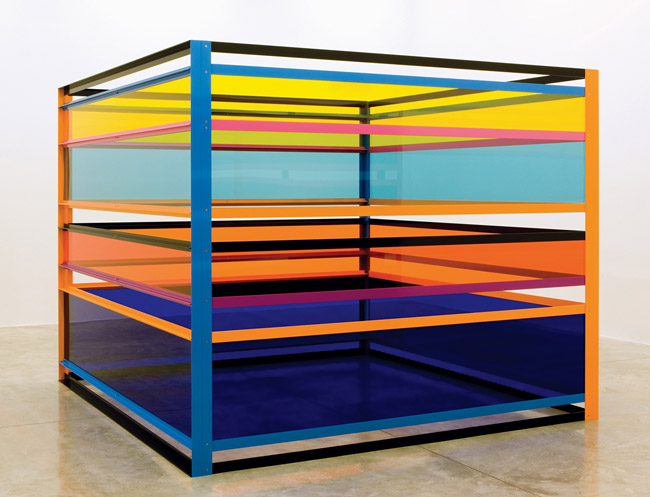
To that end, he has created the long running potential, or unwritten, text, Construcción de Uno. This unwritten text never completely reveals the artist’s intentions, but positions a hermeneutics whose unquantifiability acts as a buffer for those critics who would seek to reduce the artist’s practice to their own terms. He has revealed a few details about this text, however: one of the principle scenarios of the text, whose narrative frames this exhibition, follows the former workers of an experimental Volvo manufacturing plant located in Brazil who return to the workplace after it has been decommissioned by Ford. There they spend their time producing elegant theories on labor equivalence and begin to refashion the site as a testing ground for new models of production.
Seeing Neighborhoods Anew: Art Institutions' Enactment of the Transnational
Hyun Sook Kim
POSTPONED 3pm Saturday 7 June 2008
$museum admission (12)
In a recent lecture at the New Museum, curator Okwui Enwezor spoke on what Peter Schledhal has cynically described in 1999 as the rise of "festivalism" – large scale, International and highly visible art biennales and exhibitions. The rise of such exhibitions, the massive mobilization of cultural workers and resources necessary for their production, and the inevitable contestations for power, influence, and autonomy of the various players involved inevitably precipitates all variety of strange fruit; the cancellation of the transnational manifesta 6 in 2006 by the government of Nicosia, for example, catalyzed the foundation of Anton Vidokle's monumental United Nations Plaza project in Berlin the following year, which was only the first of three of its manifestations thus far, each growing in complexity and collaborative scope. Enwezor, who is this year's Gwangju Biennale artistic director, theorized in his talk that these kinds of exhibitions are often born in response to traumatic moments in a nation's history; the three primary examples offered of his condition being Documenta's formation in response to the end of WWII (for what could Germany be after this but a cultural power?), the Johannesburg Biennale's foundation as a response to the abolishment of Apertheid, and the Gwangju Biennale modeled in part as a kind of 15 year echo to the unrest of the 1980 Gwangju Democratization Movement. These exhibitions in a sense, Enwezor suggests, negotiate a relationship between history and trauma, and produce temporary sites where international cultural production occurring in a particular locale might suspend even those deepest and most necessary tenets of national identity. It's interesting then, to consider the role of the museum and other large-scale but geographically localized (but temporally unlimited) cultural institutions and their place in civil society. If "festivalism" leads to a disruption, reconfiguration, or perhaps even an affirmation of it's host site's relationship to the past, then on what axis does one locate the quotidian operations of the museum? Tomorrow at the New Museum, sociologist Hyun Sook Kim will lecture on "art institutions' enactment of the transnational," a look at just such questions, the constituting of the local, the contemporary art institution's collapse of such locality, and the changing role of institutions with their relationship to place. This lecture is part of the Museum as Hub program, and furthermore one of the various supporting programs of Insa Art Space's Dongducheon: A Walk to Remember, A Walk to Envision, currently on view at the New Museum's Museum as Hub space.
NOTE: The New Museum has postponed this event to a later unspecified date. This event listing was composed previous to this and published regardless; it will be reposted when the Museum reschedules the event.
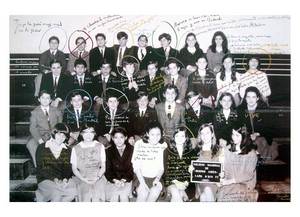
Triple Canopy, an online publishing platform that "presents writing, art, video, and other creative projects in forms that work with and against the Internet," has just released the first four parts to their second issue, Orbiting an Absent Program. Featured is an original translation of Robert Bolaño's 1999 acceptance speech for the prestigious Rómulo Gallegos Prize, an honor bestowed upon the Chilean writer for his semi-autobiographical novel from that previous year, The Savage Detectives – recently translated into English and steadily gaining popularity among North American readers since 2007. Orbiting... also features Victory Over the Sun, a streaming video transfer of a film by Michael Robinson, whose motion picture works on 16mm and video have been gaining increasing visibility in American avant-garde film circles. Robinson's work – part contemplative landscape film, part something else – is shot largely at the sites of various midcentury world fairs. It is introduced in Triple Canopy by curator Thomas Beard who locates the piece somewhere at the interstices of formalist media specificity, the legacy of Euro-American modernism, and the trajectory and future of media art's utopian Ur-narrative.
Also featured in this issue is Molly Kleiman's profile on a micro-nationalist separatist colony in the West Bosnian countryside, in which the writer examines both the colony's kitschy aesthetic sensibilities and the inherent threats of political and ethnic violence in its defining narrative and constituting everyday cultural practices. Another motion picture work in this issue, Brush by Keren Cytter, is the second in a "video melodrama in six parts," also presented here.
Triple Canopy manages to showcase content on the Internet in a novel and economic way. Combining a low-profile javascript controller with with a blog-like page organization, individual texts are spread across pages that can be "turned" with either a keystroke or a mouse click, while individual articles may still be linked directly, text can be copied, and much of the functionality of static, vanilla HTML websites is preserved.
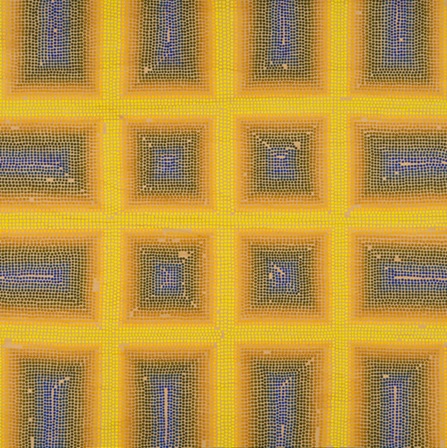
Laura Paulini's work, along with that of Derrick Melander Penelope Umbrico, was recently on view at Repetti Gallery in Long Island City.
Laura Paulini paints with her lucky chopstick. It's a cheap wooden one that she that found with a meal. Yet, the artist soon discovered that when she dipped this particular stick in tempera paint and then dabbed her birch picture planes, the dot turned out chillingly perfect. There is just something magical about the tip's shape and how it holds paint. Paulini theorizes that after many sessions of use the stick has not worn but actually calibrated to her technique. The artist has likewise honed her skill to the qualities of this chopstick. The utensil is so valuable that Paulini was tormented recently over bringing the stick along on her next residency or avoiding the risk of loss and leaving it at the studio. This modest but powerful tool looms behind each of her paintings.
Dot by dot, row by row, column by column, Paulini creates geometric Op Art patterns with a pointillist style. From a distance the Tron-like grid is clear but as a viewer approaches the field dissolves into a series of well placed dots. This game of distance and watching the image modulate with each step is one trademark of good pointillism that her works display with flying colors.
It has now been eighty-nine years since Mondrian's first grid paintings in Paris. The rigidly organized field still manages to touch a nerve on the retina. Let's forgo the predictable arguments over Rosalind Krauss's essays and appreciate the grid's tenacity when so many elements of modern painting now fall flat. The grid is like the friend you still call even though you've spent evenings cataloging his or her flaws. The grid is that dish that your mother never aces, but prepares with that bizarre twist that is her enduring signature. Paulini's work draws upon the grid's bittersweet stamina as recent painting stands between the hard rock of modernism and the harder place of what comes after.
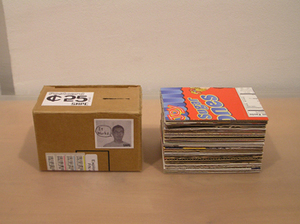
Atlantic Avenue Art Walk
7 June - 8 June 2008
Various locations, Brooklyn NY
In addition to this weekend's Bushwick Open Studios and Arts Festival, a little further south the fifth annual Atlantic Avenue Art Walk also takes place, stretching across the borough in an offering of events, screenings, performances, and open studios. The Art Walk is a self-guided tour through the neighborhoods of Brooklyn Heights, Cobble Hill, Boerum Hill, Gowanus, and Downtown Brooklyn along the historic avenue. All Art Walk events are free and open to the public. Readers interested should pursue the Art Walk's news and events page and the directions page.
The image reproduced above features one of the projects on view at this year's Art Walk: Shinsuke Aso's Postcard (SPAC), a long-term project that is "part installation, part performance, part micro enterprise" and will be presented at the Atlantic Gardens Storefront (535 Atlantic Avenue, Brooklyn) by MINUS SPACE. SPAC is an ongoing business venture as performance that produces postcards entirely from found materials and sold afterwards as cheap multiples. The project claims to derive its energy from "from the global market system, in which anything can be a source of business," becoming a double-edged allegory for the limitlessness of privatization (yes, even of discarded cardboard) and the spirit of entrepreneurship while aligning itself with a populist bend — 25 cent postcards perhaps functioning here as the least pretentious of commodities.
The Chelsea Hotel in Words and Pictures
7pm 2 June 2008
McNally Robinson - 52 Prince St New York, NY
In a city as obsessed with its own claims to an authentic, towering importance in 20th century cultural life as with a cynical emphasis on that authenticity's dispersal by the stolid grip of capital and the constant influx of would-be denizens, a few landmarks dot the city's map like fissures to an authentic bedrock somehow obscured with the passage into the new Millennium. Tonight at McNally & Robinson in SoHo, author Ed Hamilton and photographer Julie Calfee present The Chelsea Hotel in Words and Pictures, a presentation on one such historic 23rd street residence to artists both renown and . Hamilton's recently published Legends of the Chelsea Hotel, provides a kind of pop history of the site focused especially on the past 10 or 15 years. Calfee's recent book meanwhile, Inside: The Chelsea Hotel collects four years worth of photography and writing. The presentation at MR will consist of a slide show, discussion, and singing.
ZINE
HOME
TIPS / COMMENTS
CATEGORIES
CONTRIBUTORS
- Greg Afinogenov
- B. Blagojevic
- Adda Birnir
- Susannah Edelbaum
- Julie Fishkin
- Paddy Johnson
- Jessica Loudis
- Christopher Reiger
- Andrew Robinson
- Peter J. Russo
- Blythe Sheldon
- S.C.Squibb
- Hrag Vartanian

